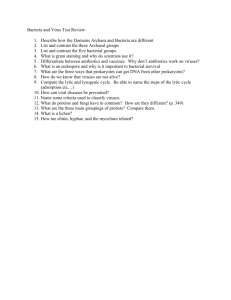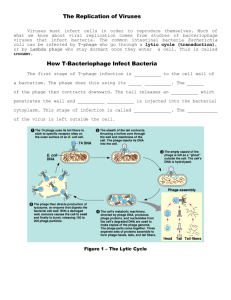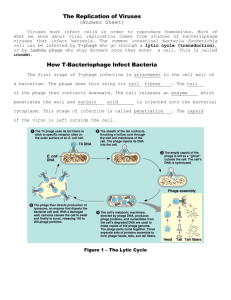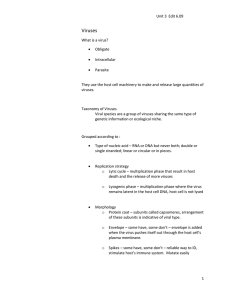Reading Guide Bacterial Viruses (CH13)
advertisement
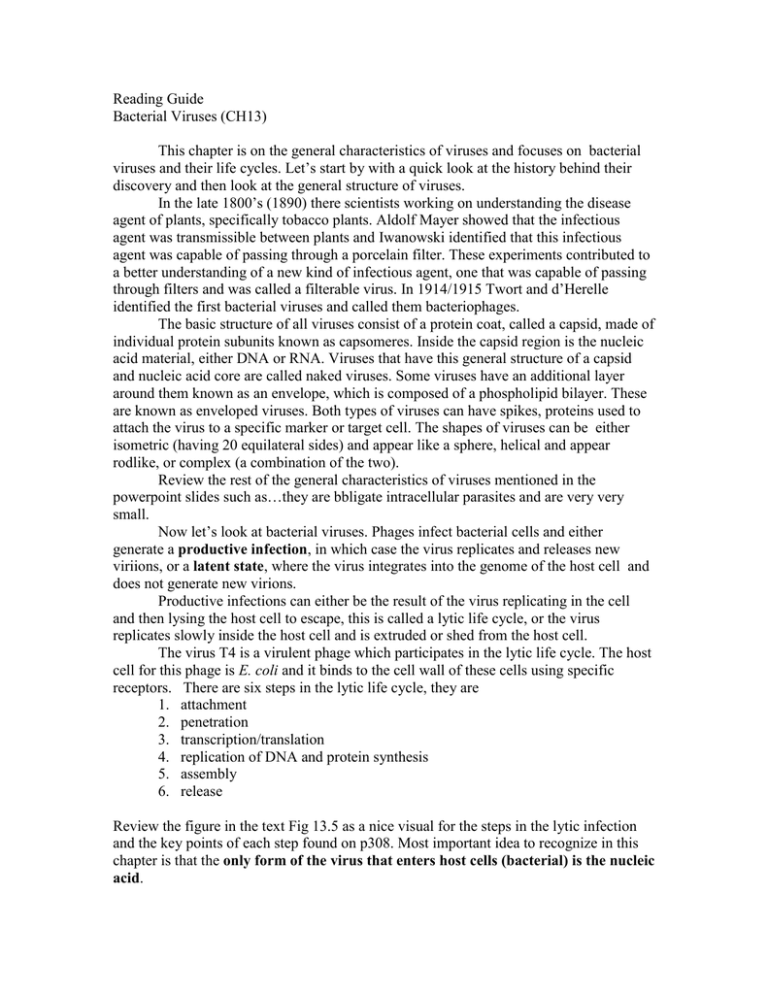
Reading Guide Bacterial Viruses (CH13) This chapter is on the general characteristics of viruses and focuses on bacterial viruses and their life cycles. Let’s start by with a quick look at the history behind their discovery and then look at the general structure of viruses. In the late 1800’s (1890) there scientists working on understanding the disease agent of plants, specifically tobacco plants. Aldolf Mayer showed that the infectious agent was transmissible between plants and Iwanowski identified that this infectious agent was capable of passing through a porcelain filter. These experiments contributed to a better understanding of a new kind of infectious agent, one that was capable of passing through filters and was called a filterable virus. In 1914/1915 Twort and d’Herelle identified the first bacterial viruses and called them bacteriophages. The basic structure of all viruses consist of a protein coat, called a capsid, made of individual protein subunits known as capsomeres. Inside the capsid region is the nucleic acid material, either DNA or RNA. Viruses that have this general structure of a capsid and nucleic acid core are called naked viruses. Some viruses have an additional layer around them known as an envelope, which is composed of a phospholipid bilayer. These are known as enveloped viruses. Both types of viruses can have spikes, proteins used to attach the virus to a specific marker or target cell. The shapes of viruses can be either isometric (having 20 equilateral sides) and appear like a sphere, helical and appear rodlike, or complex (a combination of the two). Review the rest of the general characteristics of viruses mentioned in the powerpoint slides such as…they are bbligate intracellular parasites and are very very small. Now let’s look at bacterial viruses. Phages infect bacterial cells and either generate a productive infection, in which case the virus replicates and releases new viriions, or a latent state, where the virus integrates into the genome of the host cell and does not generate new virions. Productive infections can either be the result of the virus replicating in the cell and then lysing the host cell to escape, this is called a lytic life cycle, or the virus replicates slowly inside the host cell and is extruded or shed from the host cell. The virus T4 is a virulent phage which participates in the lytic life cycle. The host cell for this phage is E. coli and it binds to the cell wall of these cells using specific receptors. There are six steps in the lytic life cycle, they are 1. attachment 2. penetration 3. transcription/translation 4. replication of DNA and protein synthesis 5. assembly 6. release Review the figure in the text Fig 13.5 as a nice visual for the steps in the lytic infection and the key points of each step found on p308. Most important idea to recognize in this chapter is that the only form of the virus that enters host cells (bacterial) is the nucleic acid. The virus lambda is a temperate virus that participates in the latent or lysogenic life cycle. Notice that is has the same host cell as T4, E. coli. This virus can enter the host cell and immediately circularizes its DNA material. At this point one of two things can occur, either the virus enters the host cell chromosome and remain dormant (meaning that no new viruses are made), or the virus enters the lytic cycle and produces more virions. To enter the lysogenic life cycle the virus must integrate into the bacterial chromosome. Lambda phage has a region on its chromosome that is identical to the sequence to the bacterial chromosome. Because the sequence is similar in a small region on both the two can combine or synapse. This feature allows the viral genome to integrate into the bacterial chromosome without a loss of genetic material. (Often when new DNA is integrated into a region that is similar, the new DNA material is “swapped” out for the old DNA). The area on the bacterial chromosome where lambda integrates is between the gal gene (codes for enzymes necessary for galactose metabolism) and the bio gene (codes for the synthesis of the vitamin biotin). Phage that are integrated into the bacterial DNA are now referred to as prophage. The virus will remain integrated as long as the repressor protein (coded for by the virus) remains on the viral DNA and represses the genes for excision (or jumping out of the chromosome. Events such as exposure to uv light can damage the repressor protein that is bound to the viral DNA and activate expression of the excision gene. The viral DNA then is “cut” out of the chromosomal DNA and enters the lytic life cycle. For the bacterial cell infected with a prophage (like lambda), there are some definite “perks”. The bacterial cell will not be infected with the same type of phage as the repressor that prevent the phage from “jumping out” of the chromosome also prevent new phage from replicating. The second “perk” to a lysogenic phage is that the bacterial cell may have new characteristics that are due to the integration of the phage DNA. There are toxins, such as the cholera toxin and botulinum toxin that are acquired from phages.

